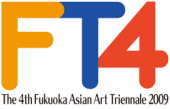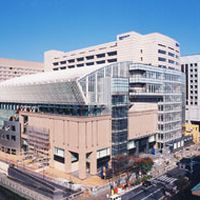The 4th Fukuoka Asian Art Triennale 2009


Fukuoka, Japan
23rd September to 23rd November 2009
Anjali Devidayal interviewed Mr. Raiji Kuroda, chief curator of the the 4th Fukuoka Triennale which was recently concluded in Japan on the 23rd of November. This two-month-long biennale, is one of a rising tide of biennales and triennales in Asia and is held in the city of Fukuoka (Japan) every 3 years.
The 4th Fukuoka Asian Art Triennale was held in commemoration with the 10th anniversary of the Fukuoka Asian Art Museum. This large scale exhibition is one that includes important artists from 21 countries in Asia including Bangladesh, Bhutan, Brunei, Cambodia, China, India, Indonesia, Korea, Laos, Malaysia, Mongolia, Myanmar, Nepal, Pakistan, Philippines, Singapore, Sri Lanka, Taiwan, Thailand, Vietnam, Japan. Works exhibited range from paintings, sculptures, video works and installations and a number of art exchange programs such as open studios, workshops, performances and gallery talks added to the interactive aspect of the exhibition. Although small in scale and budget, this event offers glimpses of the Asian contemporary art scene from an Asian curatorial perspective and has proved to attract a rising interest from both the Asian and Western art communities.
The key focus of this interview was to assess the role of Asian biennales and triennales in reflecting the growth of Asian contemporary art from an Asian curatorial perspective.
Anjali Devidayal: What is the curatorial focus of the Fukuoka Triennale and why was this, the focus for the 4th Fukuoka triennale?
Raiji Kuroda: First, we needed a retrospective of Asian contemporary art in the last decade. This does not mean a comprehensive introduction of artists who have joined the international art world, including those who have not shown in past Triennales. But we tried to choose those who successfully explored the potential of Asian culture, instead of repeating the same styles, messages, and methods to cater to commercial demands.
Second, we adopted the same strict criteria for emerging artists as well as for established ones, to choose more “serious” artists either in artistic quality or sincerity toward social issues. This lead us to the theme of “Live and Let Live: Creators of Tomorrow”. I do not mean we emphasized the art dealing with social and political issues, as often seen in some international exhibitions in Europe, but to approach global issues in conditions of survival, either in social system for labour. For example, natural phenomenon such as water supply and pollution and the close relationship of the two – in their urban and the natural relevance were shown in a wider perspective. The idea was not to compete but to present “new” ideas from the past few years.
Attracting people through festivities and events was absolutely necessary as is the strategy for all international exhibitions to get more visitors particularly in Asia, and even more so in local cities like Fukuoka that have very limited audiences for contemporary art. However I wanted the content of the exhibitions to be as strong as possible to overcome the recent tendencies in Japan where the exhibitions and art events have become amusement park for family and children.
A.D.: How do you believe this triennale will impact the contemporary art scene in Asia?
R. K.: I know important Asian people (except those rich enough and privileged for mobility) cannot come to Fukuoka except by our invitation. This is a humble Triennale in terms of scale and budget, compared with mega Triennale in Yokohama. However I feel more domestic and foreign visitors visited the Fukuoka Triennale #4 as compared to the Fukuoka Triennale 3 in 2006. This year visitors included Korean, Chinese, Singaporean, French, British, American, and Australian curators or journalists. Their response to this triennale was is in general more positive than to the last one.
A.D.: Do you think the Fukuoka Triennale (and other biennales and triennales in Asia) will become truer reflections of the growth of the Asian contemporary art scene or will the western biennales and triennales still be the deciding indicators of the development/growth of Asian contemporary art?
R. K.: The answer depends on what is “the development/growth”. Undoubtedly, yes, the spread of bi/triennales in Asian can contribute artists with the opportunity and international exposure, but it should be supported, institutionalized, systematized by bodies of sponsors, patrons, curators, collectors, as well as by audience in general. This is because Asian cities do not yet have such sustainable institutions and systems as in Western cities. For example, how many cities in Asia have reliable art museums with professional curators, managers, conservators, and educators, and complete facilities for exhibition and preservation? I know their staff and facilities are far less than minimum standard. This is just an example, as the role of art museum constitutes only a small part of the whole art scene. I mean, even if bi/triennales in Asia could be as competent as those in the West in terms of originality of content, social and philosophical challenge, and international appeal, none of the bi/triennale cities in Asia have sustainable system for contemporary art, except for some commercial market for investment, and/or the easy and quick amusement. So I would suppose Asian exhibitions work as new showrooms for Western art museums or aristocratic collectors before all of best works in Asia or by Asians find their safe home abroad.
A.D.: What do you see for the future of the Fukuoka Triennale?
R. K.: We have tried our best for the future. After that it depends on how the sponsor (city government) and/or citizens evaluate the Triennale and Fukuoka Asian Art Museum. No matter how national and international audiences appraise or criticise this event, its theme suggested the underlying survival and the quest for survival of Fukuoka Asian Art Museum as a local art museum. As some clever visitors have found, the whole project of Fukuoka Asian Art Museum (including the Fukuoka Triennale) is not only for the immediate service of the local people, it is meant for a wider international audience. Even though I have mentioned in a recent essay, Fukouka Asian Art Museum has not yet received a permanent spot on the map of Asian museums yet.
Relevant links
http://www.ft2009.org/en/info.html
http://faam.city.fukuoka.lg.jp/eng/home.html
Anjali Devidayal is the visual arts contributor for Asia for culture360.org.
She is an independent art consultant, curator and writer and works with arts organisations in developing and promoting the visual arts in Asia.
Similar content
from - to
06 Sep 2014 - 30 Nov 2014
deadline
15 Dec 2016
posted on
04 Jul 2011
posted on
01 Jul 2016
deadline
30 Sep 2014






